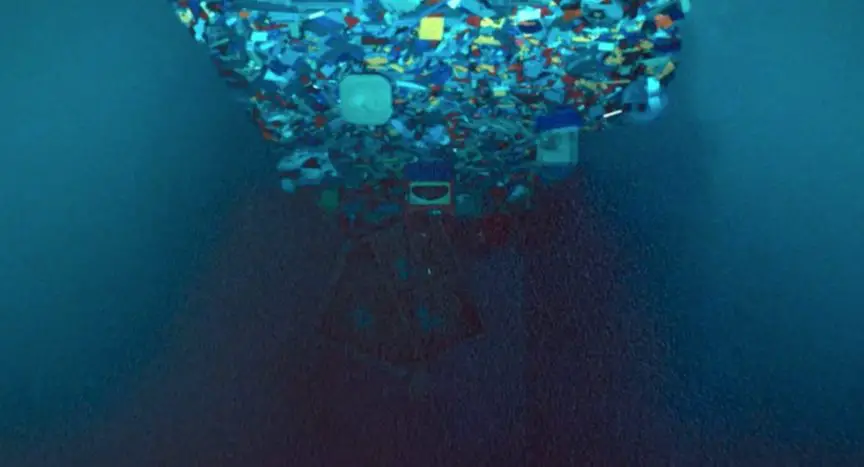Depending on the online circles that you stumble through, you may have heard the new film Skinamarink spoken of in rapturously hushed and electrified tweetspeak. All of us–being no strangers to the hyperbolic nature of each and every new thing being proffered as the latest, the greatest, and the most–must approach the hubbub with a grain of salt. Marketing shmarketing. Maybe Skinamarink is or isn’t the “scariest film” that you will ever see. There’s only one way to know for sure, right?
Where Kyle Edward Ball’s feature debut branches off from the overly lauded and yet infectiously lovable annals of Youtube ‘analog horror’, it raises interesting questions about the way audiences perceive material. Ball has very clearly and purposefully made a distinction: Skinamarink is a feature film. It is not a Youtube video–because it is not presented, or marketed, and by extension contextualized, as such. Contrarily, it is not a piece of outsider gallerist video art. Everything about the framing of the work suggests cinematic intention and aspiration–from the typeface and posture of the opening credits, to the editorial style throughout, to the tethering to theatrical distribution and exhibition that is becoming a rarer and rarer beast as the days flitter past us.
The film has supposedly brought audience members to the verge of tears through sheer terror. Meanwhile, another (much smaller) branch of online film chatter is keen to compare Skinamarink to significant works of structuralist cinema. Paranormal Activity was hardly so often spoken of in connection to the films of James Benning. Those prickly and difficult but lovable cinephiles may be way too eager to remind you of all the many films that they have heard of–but, in this case, they aren’t entirely out in left field. Anyone could easily describe Deborah Stratman’s In Order Not to Be Here as one of the “scariest films ever made.” They wouldn’t be wrong. But there’s a contextual difference between movies made for furrowed brows, scratched chins and pontification, and movies made to make you jump and shriek and hide your face in your hands. Albeit, intent may lie in the eyes of the beholder.
Did You Know? Wicked Horror TV Has Classic and Independent Horror Films Available to Stream for Free!
When it comes to Skinamarink, the perfectly delicious logline sells the whole thing: “The film follows two children who wake up during the night to discover that they cannot find their father, and that the windows, doors, and other objects in their house have disappeared.” This set-up cannot be precisely gleaned from the film itself. Skinamarink revels in the black void quality of wavering through time without narrative grounding. Unlike the majority of the structuralist work that it might aesthetically call back to, this is not conceptually–but rather experientially-minded–cinema. Ball clearly wants his audience gripped by fear. Meant to evoke the eerie sensation of traversing domestic interiors lit by televisual blue light, Skinamarink works if-and probably only if–one enthusiastically gives themselves over to the idea.
The premise manifests via the hauntingly crawling black faux-grain of the visual approach. Where it might falter as video art, it excels as a cinematic haunted house. Like Mark Z. Danielewski’s House of Leaves–another frequently-noted and infamous comparison point–Ball’s is a haunted house story about the physical structure of the house and the psychological implications thereof. The majority of Skinamarink consists almost exclusively of claustrophobic compositions showcasing architectural details: corners, walls, carpeting, doors, etc. Whether you spend these 100-minutes gripped by the fear that something might at some point pop out from behind the corner and scream at you is entirely your prerogative.
The erosion of the barrier between professional and consumerist aesthetic qualities is nothing new. Our age is one where the distinction between legitimacy and the domains of the dilettante is firmly predicated on marketing and channels of access. With examples like Skinamarink and We’re All Going to the World’s Fair one can take note of the way filmmakers are keen to transfer the ephemeral interests and thematic hallmarks of once-purely outsider online art into the marketable forms, and presentative and perceptive boundaries of ‘legitimate’ (a.k.a. commercial) media-making. By this critic’s consideration, Ball’s film is far more artistically interesting than Schoenbrun’s–mainly because it is far less beholden to preconceived notions of what commercial cinema must look and operate like. Coincidentally, Skinamarink is a far more abrasive and audience-unfriendly endeavor.
Too many smaller genre films ask too much of their audience without giving an equivalence back. I will always remember consciously growing further jaded when a much buzzed-about indie horror movie from a few years ago asked us to be frightened by the horrifically shocking jolt of…toast popping out of a toaster. Skinamarink is not without shades of this type of far-fetched genre indulgence. (Bang! Gotcha.) But this film stretches the extents of the form so delightfully far–the silence before the jump-shock(s) is so caliginous and unending, so abstract and physically nauseating. Perhaps the film does demand too much of most audiences in certain respects, but for all that it requests it fittingly gives back. It rewards an attentive submission to its specific strategies and phantasmagoria.
The ending of Skinamarink is well worth the wait and emotional investment. A ferociously melancholy series of spiraling anti-set-pieces culminate in a final image of astonishing beauty. This prolonged final moment is a frayed nerve on the verge of shredding into nothingness; the nightmarish oblivion of nonexistence through a sickening pursuit of cinema’s illusory shadows. It is cataclysmically perfected. It sinks and holds and drones to an unnerving extreme. It is scary. And it is so worth it.
Skinamarink will open exclusively in theaters nationwide January 13, 2023.
WICKED RATING: 7/10
Director(s): Kyle Edward Ball
Writer(s): Kyle Edward Ball
Stars: Jaime Hill, Lucas Paul, Ross Paul, Dali Rose Tetreault
Release date: January 13, 2023
Language: English
Run Time: 100 minutes
